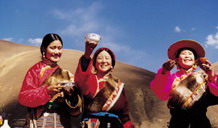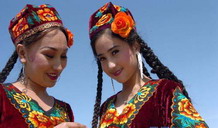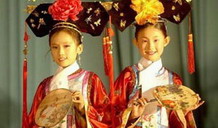The Mongolian Ethnic Group
With a total population of over 4.8 million (as of 1990), the Mongolians live mainly in the Inner Mongolia Autonomous Region. Some are distributed in Xinjiang, Liaoning, Jilin, Heilongjiang, Gansu and Qinghai provinces. Others are scattered in Sichuan, Ningxia, Yunnan and Beijing.
The Mongolians have their own spoken and written language, which belongs to the Mongolian Austronesian of the Altaic Phylum. The Mongolians have three dialects: Inner Mongolian, Barag-Buryat and Uirad. The Mongolian script was created in the early 13th century on the basis of the Huihu script, which was revised and developed into the form used up to now.
The Mongolians have kept their nomadic living style for hundreds of years. "Mongolian" originally was the name of one of the Mongolian tribes roaming along the Erguna River. At the beginning of the 13th century, a Mongolian tribe headed by Genghis Khan unified all the Mongolian tribes, giving birth to a new people -- the Mongolian ethnic minority. In 1206, he was elected the Great Khan of all Mongols with the title of Genghis Khan. Kublai Khan, the grandson of Genghis Khan founded the Yuan Dynasty (1206-1368) in 1272, and subdued the Southern Song (1127-1279) in 1279, bringing the whole of China under his centralized rule.
Living on grassland, the Mongolians rely on raising stock as their economic mainstay. Kumiss and roasted mutton are their favorite food and drink. Nowadays, they are also engaged in agriculture and industries.
The Mongolians have a fine cultural tradition, and made indelible contributions to Chinese culture and science. They created their script in the 13th century and later produced many outstanding historical and literary works, including theInside History of Mongolia, which has been listed as one of the World Cultural Heritage in China by the UNESCO. Other great works of folk literature include theLife Story of Jianggar, an epic of the 15th century. Mongolian medicine has been best known for its Lamaist therapy, which is most effective for traumatic surgery and the setting of fractured bones.
The Mongolians believe in Lamaism. They are hospitable, zealous and frank. They always offer the breast and tail of the sheep or lamb as a special treat to distinguished guests, and drink wine and sing songs to entertain guests while they eat. Presenting Hada, a strip of white silk, to the guest is the highest etiquette of the Mongolians.
On the grassland, the Nadam Festival is held each August by the Mongolians to celebrate their good harvest, lasting five to seven days. Contests such as archery on horseback, wrestling, horse racing and other traditional activities are held. The Bai Festival is the Mongolian New Year.
Living Areas: The Mongolians in Xinjiang live mainly in Bayangolen and Bortala Mongolian autonomous prefectures and Hoboksar Mongolian Autonomous County.
Population: According to the 2003 census, the Mongolian population of Xinjiang totaled 166,900, 0.86 percent of the regional total.

Language: Xinjiang's Mongolians speak the Uirad dialect of the Mongolian language, which belongs to the Altaic language family. Both the Tuote and Hangul scripts are accepted as its written forms, with the latter more commonly used in China.






